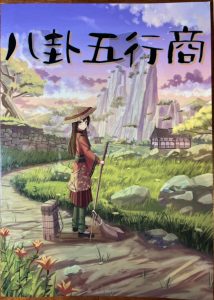 As a kid I adored the Torneko story arc and running a shop in Dragon Quest IV, so when I saw the indie TRPG Hakke Gogyou Shou (八卦五行商) and its beautiful cover, I was immediately intrigued. A slim fourteen black and white pages with a glossy cover, it’s a game of merchants peddling their wares in an ancient China inspired fantasy.
As a kid I adored the Torneko story arc and running a shop in Dragon Quest IV, so when I saw the indie TRPG Hakke Gogyou Shou (八卦五行商) and its beautiful cover, I was immediately intrigued. A slim fourteen black and white pages with a glossy cover, it’s a game of merchants peddling their wares in an ancient China inspired fantasy.
The name itself is composed of three words: Eight Trigrams Divination (八卦), Five Elements (五行), and Merchant (商), with the shapes behind the title corresponding to the concepts. Not being very familiar with them and the book assuming some familiarity, a bit of research helped with reading.
What’s needed
Playing cards, one d4, 4d6, 1-2 d10, and a calculator! The first few items are pretty standard, but the recommendation to use a calculator caught me by surprise. After reading the book, I understand the recommendation. Some of the beginning and ending calculations used by the game involve division and multiplying percentages to determine costs and profit. That being said, the central game play of traveling can be done without a calculator.
Character Creation
The three primary attributes of Mind (心), Body (体), and Skill (技) are used when a character makes a check. There are also support versions of these attributes that a character may spend to assist other characters. Doing so decreases the support attribute until a feast is held at the end of the game.
Characters have four resources to work with:
- Vitality (活力). Similar to hit points, when this becomes zero characters are unable to perform tests. Carrying a character as “luggage” is 25 costs Transportion
- Spirit (霊力). Similar to MP, it’s used to power special abilities. Regenerates a bit each day.
- Carrying Capacity (携行力) How much the character can carry on them.
- Transport (運搬力) How much the character can transport. In contrast to Carrying Capacity, this cannot be used during encounters unless specified.
After determining personal details, they determine their history rolling 2d8 and consulting the “Thus Far” column in a table of 64 options. Foretelling their future is done the same way, but consulting using the “From now” column. Each entry has an upper and lower affinity listed, which comes from I Ching Hexagrams.

Attributes
Characters have a primary and secondary essence chosen from one of Eight options:
- Heavens
- Marsh
- Fire
- Thunder
- Wind
- Water
- Mountain
- Earth
The primary and secondary essences determine the primary and secondary stats. Aid stats are used to aid other characters with a check, and doing so decreases the used attribute by 1. Essences either increase the primary stat or assistance stat, but not both.
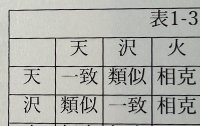
Next, a character’s resources are determined by consulting the relation between the primary and secondary essences. Strengthening (相生) boosts Vitality; Weakening (相克) boosts Spirit; Similar (類似) boosts Carrying Capacity, and a Match (一致) increases Transport.
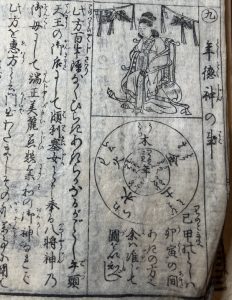
On a side note, charts in this book reminded me of those in old books related to divination and astrology. Here’s an image from a book I happen to own.
Characters choose a skill associated with their primary and secondary essences. Each skill costs some Spirit to use. For example, if the character has a Heavens essence, they could choose the Heaven skill “Heaven’s Blessing”, which costs 30 Spirit to use and restores 20 Vitality to each party member when they rest.

Finally, characters begin with 1,000 Hun (currency), and may spend half of that for carried items.
Items
Items have a number, category, main essence, secondary essence, transport cost, and standard price, and (optionally) an effect. Most effects only happen when carried or used, but others take effect during transport or other events. For example, food loses 5% quality each day.
Items start with 100% quality, but can decrease over time. They also have a primary and secondary element, which affects pricing when being sold. For example, Honey has a primary element of Wood and secondary element of Fire. The market price of both elements affects the cost to buy and sell.
Checks
Tests are resolved by rolling a number of dice equal to the relevant attribute, skill and item effects, as well as aid. Each die with a result of 5 or more is a success, and a number of successes equal to the difficulty must achieved. The default difficulty is one.
Session Flow
Beginning
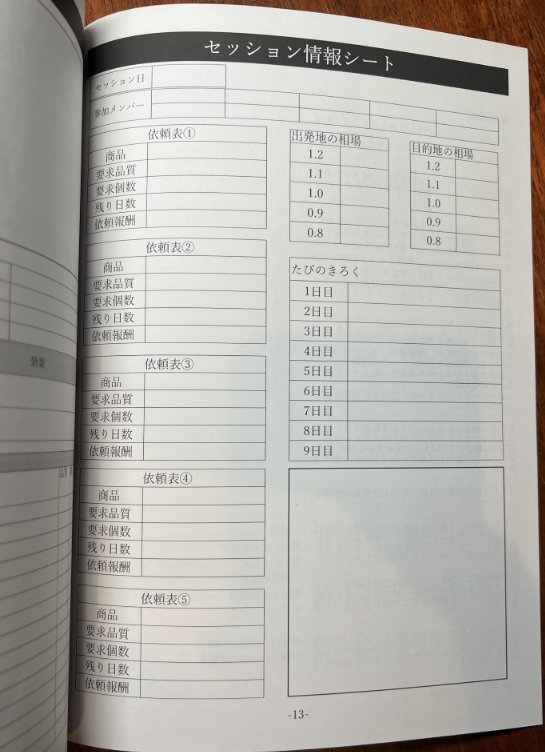
The session begins with the PCs gathering at a trader’s guild. The GM then generates three requests from a trade association. Item requests are generated randomly from the items table by rolling 2d10. Next the requested quality (50 + 3d10%) is determined, as well as the number of items (100 / transport cost – 2d10, round up, minimum of 4). Remaining days is the number of GM planned events plus 1d4. A number of playing cards equal to the number of days are drawn to form the travel deck. Finally, the compensation is calculated based on a formula based on the request details.
Market prices (相場) for two of elements is determined. This is done randomly, with these resulting elements being assigned value multipliers of 1.2 and 1.1. The remaining value multipliers (1.0, 0.9, and 0.8) are filled in later.
Departure
With the stage set, players may prepare for their travels with one of six actions:
- Look for a shop with good deals
- Gathering market prices for the departure town
- Gather market prices for the destination
- Gather information about the requesting client
- Find requests not handled by the trade guild.
- Purchase goods.
A day passes when all players have taken an action. This counts towards delivery deadlines, so preparation must be balanced with travel time.
Travel
Once the traders set out on the road, the following three actions occur for each day of travel:
- Check the compass to determine the correct heading. This is a group check that, if successful, gives a boost the Rest check. Failure adds a card to the travel deck, but gives a boost die for subsequent compass checks.
- A card is drawn from the travel deck to determine what event takes place, as well as the weather and terrain.
- Due to an issue during printing, the Travel Chart (旅路表) was missing, but the author provided it on Twitter.. Events can have have positive or negative effects. For example, item seven “Beset by Bandits” results in transported goods being lost, but a Body check can offset the loss. The next option is finding a “Thief’s Hideout”, where the characters find an item.
- In addition to travel events, the drawn card is used to determine terrain and weather changes. Odd numbers change terrain and even number determine the weather.
- Rounding out the travel day is making camp and resting. A Spirit check reduces the amount of Stamina lost during the day, but can only be made if a Ration is expended.
Arrival
The characters have arrived at their destination, and it’s time to fulfill orders and sell wares. A representative makes three rolls to determine the results of fulfilling an order. A character may only represent one order, so it’s not possible for a single skilled trader to sell everything.
Three calculations are made: 1) travel time and first impressions 2) quantity and product knowledge and 3) quality. The results of these calculations are multiplied by the standard price, primary element modifier, and secondary element modifier to arrive at a sale price. After the requested items have been sold, optional items can be sold using a simpler calculation.
Now that business is concluded, it’s time to celebrate success. Characters regain Stamina and Spirit automatically, but must pay to recover their assistant attributes.
World Setting
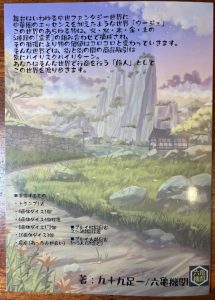
The world setting is explained in a page with enough details understand a character’s place in the world and inspire stories.
For the average person, manipulating elements helps with daily life, but is not a necessity. People normally take up the family trade, but some decide to strike out on their own, using elements to ease their journeys.
There is a traders guild, as well as three trade associations. The default setting is the Earth Kingdom, which is surrounded by kingdoms of the four other elements.
Afterwards
In addition giving thanks to testers and the cover artist, the author give some background on how the game came to be. It’s their first time to finish creating a TRPG, and doing so made them appreciate the work that went into all the games they’ve played up to now. The original impetus to make a game was GM’ing at Game Market and being asked if they were the game’s author; wanting to answer “Yes”, they made their own game.
Acquiring
Only available as a physical book, it’s available from Conos and directly from the author at Tokyo Game Market.
| Hakke Gogyou Shou (八卦五行商) | |
|---|---|
| Time | 3-5 hours |
| Players | 3-5 people, including the GM |
| Creators | Group: Hex Game Systems (九十九足/六亀機関) Author: 九十九 足一(ツクモタイチ)/玖枕 Cover Artist: ソウムラ |
| Details | Official Twitter Conos |


Wow, I’ve only played Dragon Quest IV recently. And when I did I understood why Torneko is such a popular character! This game sounds great, and I vibe with the traveling merchant mechanics. Ancient China from a medievalist point of view is one of the most perfect settings for such a game. Arabian nights being another.
Also “GM’ing at Game Market and being asked if they were the game’s author; wanting to answer “Yes”” is the most wholesome reason to create a game I ever heard! I love it!
Right! I loved that reason for wanting to create a game. The afterward spoke to me on several levels, including accumulating game books ?
I’m with you on liking traveling merchant mechanics. Arabian nights would be a great setting as you mention. Using the object essences for pricing is really elegant, allowing any type of object and variable pricing without getting overly detailed with ingredients.
How did you like Dragon Quest IV? I often rented it as a kid, but only beat it as an adult when I picked it up for Nintendo DS.
Thank you as always for taking the time to read and comment!
I finished the Nintendo DS version as well. I really liked the character designs in IV! I can see how it influenced other RPGs and Fantasy works. Although the story driven game limited the exploration a little bit compared with DQ III. I’m now going through DQ V, I tried doing the SNES version, but there are some things that are too time consuming in the SNES version. Like buying potions… You need to buy one at a time and go through all the dialogue. So I’m now playing the DS version of V.
And… I just found out that IV was supposed to have a Party Chat, but the feature was removed from the DS version… I really feel I missed out.
> You need to buy one at a time and go through all the dialogue
Oh yeah, that’d drive me crazy. Reminds me of putting text speed on fast and then missing something important.
> supposed to have a Party Chat
Really? I’m trying to remember if I played the Japanese or English version. Party Chat sounds familiar, but not sure now… sounds like a lot of interesting content. I guess the mobile versions have it restored. Too bad that it was cut from the English DS version.
I’ve been meaning to check out some of the Dragon Quest and FF games I missed over the years. I had trouble getting into DQ 11, but maybe it’ll stick with a second try.